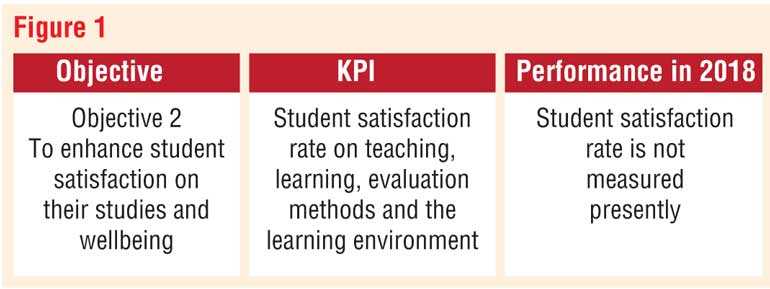Sunday Jan 19, 2025
Sunday Jan 19, 2025
Tuesday, 6 April 2021 00:00 - - {{hitsCtrl.values.hits}}

Ragging is only the tip of the iceberg. Underneath it lays the social, cultural, economic erosion that has been taking place during the last 40 years – Pic by Shehan Gunasekara
 Among many national priorities discussed today, the subject of higher education and universities is prominent. Irregularities in university intake, lack of facilities, IT skills, English language proficiency and leadership, inadequacy in relevance, quality and applicability of research output and graduate output, mismatch with the job market, and ragging and its inhuman nature are among many that have drawn attention.
Among many national priorities discussed today, the subject of higher education and universities is prominent. Irregularities in university intake, lack of facilities, IT skills, English language proficiency and leadership, inadequacy in relevance, quality and applicability of research output and graduate output, mismatch with the job market, and ragging and its inhuman nature are among many that have drawn attention.
Parents, academics, non-academic and administrative staff, support staff, student community, undergraduates, graduands, graduates, society, state universities, UGC, Minister and the Government all are concerned and express dissatisfaction over the affairs of state universities. Issues start before a student enters the university and continue even after graduation. According to the Department of Census and Statistics, in 2017, out of 253,330 students sat for GCE (Advanced Level) Examination, 163,104 (64%) had qualified for university entrance, but only 24,000 (14%) seats were available in state universities.
During the current discourse on ‘University Education’, ‘ragging and its inhuman nature’ is identified as the most disturbing factor. I am (un)lucky to have come across UGC Circulars, innumerable articles published in journals, and print media, and some reports related to ragging.
Ragging is understood as part of the university sub-culture which aims at socialising the newcomers to adjust to the new environment. This is intended to break the ice and also allows juniors to get to know seniors. Ragging has become a fashion or one can say a routine in universities. Many causes are attributed to ragging. Victims of ragging face problems from physiological, psychological, emotional and behavioural to changes in cognitive patterns, stress and physical injuries.
Wikipedia says; “Ragging is widely prevalent in Sri Lanka. Traditionally, ragging would entail seniors mocking or jeering at freshers within a dedicated period of time known as the ‘ragging period’. Ragging devolved into a violent and hazardous exercise.”
I have forgotten most of the faces and incidents took place more than a half a century ago in the most beautiful place hidden between Hantana mountain range and Mahaveli River. One thing I would not forget is how I was ragged by my seniors and how I ragged my juniors. Once I was asked to empty a pond located in front of a girls’ hostel with a coconut shell. I still cherish the incident. Ragging was not a subject discussed in university parlours a few decades ago. But, today it’s being discussed more than technology, innovation, research, quality, and university ranking. Opinions are being made by policy makers, academics, medical, psychological, education specialists, journalists, disciplinarians, and others in a long list. Majority of them are university products of yesteryear. They, like me, bear and cherish the memories of their university days.
Wherever it started, whatever forms it takes, how harmful, mild or harsh it is, ragging is condemned. Considering more harm done than good, ragging in the present form needs eradication. The Government, UGC and respective universities have issued circulars, introduced measures and taken action to combat it. They are mostly, if not all, punitive actions against perpetrators who have been reported or caught in the act of ragging. However, ragging continues unabatedly and so do the discussions and actions. The complexity involved in the issue of ragging does not allow reaching the root cause.
Some have cited lack of supervision and lack of implementation of serious anti-ragging measures by university authorities, absence of adequate guidance, vacant or no posts of wardens in the hostels, non-staying of many wardens in the hostel among reasons.
“The Committee of the Vice Chancellors and Directors (CVCD) in a statement issued in July 2020, categorically condemns all forms of ragging in educational institutions of Sri Lanka and no Vice-Chancellor or Rector would condone and support ragging or protect perpetrators. However, the CVCD believes that ragging is a complex issue that needs many interventions for it to be eliminated from the Sri Lankan universities…”
“Eradicating ragging requires a bottom up approach that goes beyond punitive measures; ragging is a phenomenon that cannot be viewed in isolation from the country’s socio economic context; there is a degree of societal tolerance when it comes to various forms of violence, and ragging is one such example where there is impunity; violence in campuses is enabled by the lack of monitoring and accountability at different levels”. These are some sentiments expressed by panellists at a webinar on the ‘Violence in Sri Lanka’s Higher Education Institutions’ held in June 2020.
Cause behind the curse
These views suggest that we look at ragging only as a curse but ignore the cause behind the curse. Ragging took a mild form of playing the fool during our time in the university. Now it takes the form of sexual and physical abuse. Ragging is only the tip of the iceberg. Underneath it lays the social, cultural, economic erosion that has been taking place during the last 40 years. The economic background of the present student community is completely different from student days of ours who write, speak, recommend, decide, and take punitive measures. We were born and bred in a prosperous, producer driven real economy built up by rural based Sennayakas and Bandaranaikes.
It is, today, replaced by a debt-ridden, service-oriented, import-dependent, declining financial economy created with unprecedented overnight liberalisation introduced by Metropolitan based JRJ. The present student generation is born and bred in the latter mentioned economy. Economic erosion caused by the so-called open liberal economy is pardonable as we can please our eyes, rather than the tongue, with chemical infected apples and grapes instead of sweet tropical mangoes, papayas, pineapples and bananas at a wayside fruit stall. But, never the social, cultural, moral, value erosion and the degradation from a knowledge creating free education introduced by Kananagara with a well-dispersed Central College network to an examination focused training by ‘Nihal Sir’ at a wayside tuition shop.
Majority of the university students are coming from economically weak, deprived, marginalised, uneducated families. Their parents do not have a stable source of income. They depend on charity, loans or even petty thefts. Some resort to brewing illicit liquor, drug trafficking and stealing. Some parents are bedridden. Majority of students depend on Mahapola or other grant schemes. There are some students who pay only the room rent from the grant they get and send the balance home to settle their paralysed mother’s medical bill; or to buy a packet of milk powder for their young sister. Those who lack food for the body come in search of food for thought to university. They are deprived of both. Gamage, Siri, (2017), in his article on ‘Psychological, Sociological and Political Dimensions of Ragging in Sri Lankan Universities’ says, “Those from lower socio-economic and rural backgrounds see those from well to do families and urban schools or with western outlooks in behaviour (dress, hair style, English language ability, social contacts, etc.) as class enemies who needed to be tamed and put in their place.”
The life of a university student today is vastly changed from the luxury cherishing romantic life we enjoyed during our university days. Cherished picture (dream) of Hantana of a yesteryear graduate who loves aesthetics is well-depicted in the following song beautifully sung by Late Pandith Amaradeva.
‘Hantane Kandu Muduna Sisara – Pawanak Vee Ennam’
Reality of present day unaesthetic graduate is depicted in following song sung by Visharada Nanda Malini.
‘Hanthana Adaviye Maduru Kavulu Sudu Sandalu Thala Pisa Me Enne Premaye Suwanda Nowe’
You may go to following links and listen to the two songs:
1.https://www.youtube.com/watch?v=6tUC_KfuM6E
2.https://www.youtube.com/watch?v=-ON8OgXEKvY&list=RD-ON8OgXEKvY&start_radio=1&rv=-ON8OgXEKvY
Ragging is only a part of a story
Ragging is committed by university students. Ragging is only a part of a story. In addition to ragging there are other matters related to students. Student satisfaction, welfare, IT and language skills, facilities available are few of them. Regrettably, we don’t consider and attach the same degree of importance and priority to other matters. Exams are not held on time; results are not released on time; there are no adequate accommodation and other facilities required by students; student-teacher relationship is strained. Lapses of this nature is a cause for student violence and unrest. Their disappointment, frustration and envy is unleashed through violent, molesting ragging. Seniors get a sense of superiority or relief from their pains by dominating/subjugating juniors; they burst out their psychological tumours through ragging, and the juniors next year do the same to newcomers.
Producing graduates is treated as the main function of universities. Universities exist as long as students and their satisfaction on teaching, learning, evaluation methods and the learning environment are present. An extract taken from a performance report of a university on student satisfaction is given in Figure 1. It shows the importance attached to student satisfaction.
During our days in the university, the entire academic staff was present on the premises from morning till dusk. We, the students had access to them and consult on any matter. There was a close relationship between academics and students. We did not have to seek extra mentoring. We were known by names and even by our nick names. Today, academics are more absent than present on the premises. They are busier on outside assignments. Some universities employ more temporary/visiting lecturers than the permanent staff. Students do not find teachers for mentoring, consultation or a sweet chat. When you talk to academic members privately they admit that a wedge is created between them and students. Students vent their feelings, annoyance, frustration on other students and juniors. Ragging is one consequence.
There are brawls and disputes arising among students due to many reasons. Some are personal; some are romantic; some are difference of opinions; some are ragging. They all go into the basket of ‘Ragging’. Ragging is not always initiated by seniors. See the following extract taken from a report of an inquiry conducted by a retired High Court Judge on a complaint made against senior students on ragging.
“The complainant student Ms……is basically responsible for the incident as she had initiated by doing something unacceptable………..”.
We write about present day university products and prescribe punitive actions against the perpetrators of ragging in good faith of eradication. But we are not sensitive to economic, social, cultural changes (erosion) taking place at large in the society. The present form of ragging is only the symptom of a disease or a pandemic. Eradication of ragging needs a long process of addressing the causes spelt out above rather than the curse alone. At present, mentoring and counselling facilities are arranged by universities and parents for the victims. But, counselling is more needed for perpetrators. There is a need to take a holistic view of the picture rather than addressing elimination of ragging in isolation.
Reference:
Ragging; Its Evolution and Effects: A Literature Review with a Special Reference to Sri Lanka – Gunatilaka H. Department of Business Administration, University of Sri Jayewardenepura – International Journal of Research and Innovation in Social Science (IJRISS) |Volume III, Issue X, October 2019|ISSN 2454-6186

(The writer has served as a Secretary to three ministries before his retirement. He is currently a Vice President of Sri Lanka Economic Association. He can be reached via [email protected].)